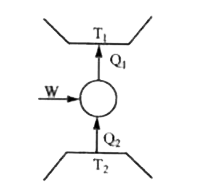A heat engine absorbs heat q1 from a source at temperature T1 and heat q2 from a source at temperature T2. Work done is found to be J(q1+q2). This is in accordance withSolution in Telugu
Violates 1st law of thermodynamics
Violates 1st law of thermodynamics if Q1 is negative
Violates 1st law of thermodynamics if Q2 is negative
Does not violate first law of thermodynamics
The correct Answer is:D
Step by step video, text & image solution for A heat engine absorbs heat q_(1) from a source at temperature T_(1) and heat q_(2) from a source at temperature T_(2). Work done is found to be J (q_(1) + q_(2)). This is in accordance with by Chemistry experts to help you in doubts & scoring excellent marks in Class 11 exams.
Topper's Solved these Questions
- BOOK - AAKASH SERIESCHAPTER - CHEMICAL THERMODYNAMICSEXERCISE - OBJECTIVE EXERCISE - 1 (EXOTHERMIC AND ENDOTHERMIC REACTIONS)8videos
CHEMICAL THERMODYNAMICS
- BOOK - AAKASH SERIESCHAPTER - CHEMICAL THERMODYNAMICSEXERCISE - OBJECTIVE EXERCISE - 1 (HEAT OF FORMATION)14videos
CHEMICAL THERMODYNAMICS
- BOOK - AAKASH SERIESCHAPTER - CHEMICAL THERMODYNAMICSEXERCISE - SUBJECTIVE EXERCISE- 4 (VERY SHORT ANSWER QUESTIONS)5videos
CHEMICAL THERMODYNAMICS
- BOOK - AAKASH SERIESCHAPTER - CHEMICAL THERMODYANMICS EXERCISE - Questions For Descriptive Answers28videos
CHEMICAL THERMODYANMICS
- BOOK - AAKASH SERIESCHAPTER - ELECTRON MIGRATION EFFECTS EXERCISE - QUESTIONS FOR DESCRIPTIVE ANSWERS10videos
ELECTRON MIGRATION EFFECTS
Similar Questions
Which of the following reaction do you think will result in the absorption of heat ?
03:59View Solution(A): Enthalpy of graphite is lower than that of diamond.
(R): Entropy of graphite is greater than that of diamond.03:24View SolutionGive Gibbs Equation.
07:54View SolutionHow does heat of neutralisation value change with the chemical nature of acid and base?
03:59View SolutionHyperconjugation effect is also termed as 'no bond resonance'. Why?
04:20View SolutionA heat engine absorbs heat Q_(1) at temperature T_(1) and Q_(2) at temperature T_(2) . Work done by the engine is (Q_(1)+Q_(1)) . This data:
03:22View SolutionThe efficiency of a heat engine is defined as the ratio of the mechanical work done by the engine in one cycle to the heat absorbed from the high temperature source . eta = (W)/(Q_(1)) = (Q_(1) - Q_(2))/(Q_(1)) Cornot devised an ideal engine which is based on a reversible cycle of four operations in succession: isothermal expansion , adiabatic expansion. isothermal compression and adiabatic compression. For carnot cycle (Q_(1))/(T_(1)) = (Q_(2))/(T_(2)) . Thus eta = (Q_(1) - Q_(2))/(Q_(1)) = (T_(1) - T_(2))/(T_(1)) According to carnot theorem "No irreversible engine can have efficiency greater than carnot reversible engine working between same hot and cold reservoirs". A carnot engine whose low temperature reservoir is at 7^(@)C has an efficiency of 50% . It is desired to increase the efficiency to 70% . By how many degrees should the temperature of the high temperature reservoir be increased?
View SolutionThe efficiency of a heat engine is defined as the ratio of the mechanical work done by the engine in one cycle to the heat absorbed from the high temperature source . η=WQ1=Q1−Q2Q1 Cornot devised an ideal engine which is based on a reversible cycle of four operations in succession: isothermal expansion , adiabatic expansion. isothermal compression and adiabatic compression.
_E01_238_Q01.png)
For carnot cycle Q1T1=Q2T2. Thus η=Q1−Q2Q1=T1−T2T1 According to carnot theorem "No irreversible engine can have efficiency greater than carnot reversible engine working between same hot and cold reservoirs"._E01_238_Q02.png)
Efficiency of a carnot's cycle change from 16 to 13 when source temperature is raised by 100K. The temperature of the sink is-01:09View SolutionA heat engine absorbs heat Q_(1) at temperature T_(1) and heat Q_(2) at temperature T_(2) . Work done by the engine is (Q_(1)+Q_(2)) . This data
02:16View Solutionयदि कार्नो इंजन में स्त्रोत से T1 ताप पर ली गयी ऊष्मा Q1 तथा T2 ताप पर सिंक को दी गयी ऊष्मा Q2 हो तो निम्नलिखित में कौन - सा कथन सत्य हैं ?
View Solutionआदर्श ऊष्मा इंजन में स्त्रोत व सिंक के ताप क्रमशः T1 तथा T2 स्त्रोत से ली गयी ऊष्मा Q1 तथा सिंक को दी गयी ऊष्मा Q2 है । इन राशियों में परस्पर क्या सम्बंध हैं ?
03:47View SolutionA heat engine absorbs heat Q1 at temperature T1 and heat Q2 at temperature T2, work done by the engine is J (Q1+Q2) this data
01:55View SolutionA heat engine absorbs heat q1 from a source at temperature T1 and heat q2 from a source at temperature T2. Work done is found to be J(q1+q2). This is in accordance with
02:16View Solutionएक ऊष्मा इंजन एक स्रोत से ताप T1 पर q1 ऊष्मा अवशोषित करता है तथा एक अन्य स्रोत से तापा T2 पर q2 ऊष्मा अवशोषित करता है। किया गया कार्य (q1+q2)J पाया जाता है। यह किस नियम के अनुसार होता है?
02:14View SolutionConsider a heat engine as shown in Fig. Q_(1) and Q_(2) are heat added to heat bath T_(1) and heat taken from T_(2) in one cycle of engine. W is the mechanical work done on the engine If Wgt0 , then possibilities are: a) Q_(1)gtQ_(2)gt0 b) Q_(2)gtQ_(1)gt0 c) Q_(2)gtQ_(1)lt0 d) Q_(1)lt0,Q_(2)gt0
03:07View SolutionConsider a heat engine as shown in Fig. Q1 and Q2 are heat added to heat bath T1 and heat taken from T2 in one cycle of engine. W is the mechanical work done on the engine

If W>0, then possibilities are :
a) Q1>Q2>0
b) Q2>Q1>0
c) Q2>Q1<0
d) Q1<0,Q2>003:09View Solution

